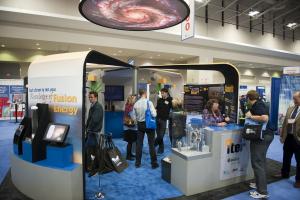A year of significant transition for US ITER
25 Feb 2011
-
Ned Sauthoff, Project Manager, U.S. ITER
The US ITER exhibit — featuring a rotating "galaxy," new video program, hands-on plasma "toys," and interactive fusion quiz—was lauded as one of the meeting's best.
Members of our US ITER team recently returned from Washington, D.C., where we displayed a large exhibit at the annual meeting of the American Association for the Advancement of Science.
During the meeting, thousands of scientists, media members, and science students and educators learned about exciting research discoveries and projects, including our very own. Our exhibit—featuring a rotating "galaxy," new video program, hands-on plasma "toys," and interactive fusion quiz—again was lauded as one of the meeting's best.
While in our nation's capital, we also met with members of Congress and their staffs at a special information reception. Joining Director-General Osamu Motojima and me as hosts were the directors of Oak Ridge, Princeton, and Savannah River National Laboratories; officials from the US Department of Energy; and executives from US ITER suppliers AREVA Federal Services, Luvata Waterbury, and Oxford Superconducting Technology. We all appreciated the opportunity to discuss the progress, challenges, and importance of our effort to provide the next step toward fusion energy as a power source.
This promises to be a year of significant transition for US ITER, as we move from the research and development/design phase into the fabrication stage. As part of this effort, we are continuing to incorporate critical input from industry into our planning processes as early as possible.
During the first week in April, we will host members of the Department of Energy (DOE) Office of Science/Office of Project Assessment review team, who will conduct an in-depth evaluation of our plans, processes, and progress. We look forward to this opportunity to interact with our peers as we discuss ways to improve the effectiveness and efficiency of our project activities.
In another important area, our team is on schedule to complete preliminary design packages for our large-value technical subsystems in support of our planned request for Critical Decision-2 (US baseline) by mid-February 2012.


